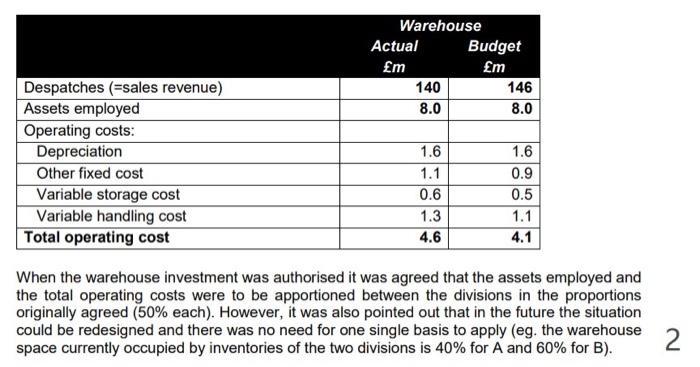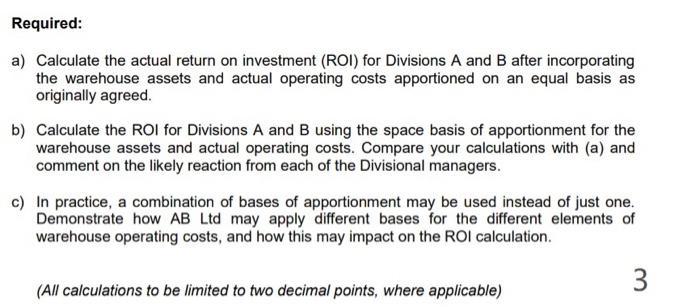Answered step by step
Verified Expert Solution
Question
1 Approved Answer
AB Ltd operates retail stores throughout the country and has a divisional structure with two divisions A and B. A centralised and automated warehouse



AB Ltd operates retail stores throughout the country and has a divisional structure with two divisions A and B. A centralised and automated warehouse that replenishes inventories using computer-based systems supports the work of these divisions. For many years' AB Ltd has given considerable autonomy to divisional managers and has emphasised return on investment (ROI) as a key performance measure. This is calculated after apportionment of all actual costs and assets of the business, and its appropriate service facilities', which includes the costs and assets of the warehouse. The following information is available for last year: Sales revenue Assets employed Operating profit Division A Actual m 30 20.0 4.3 Budget m 50 Division B Actual m 110 48.0 14.7 Budget m 96 These actual figures do not include the apportioned costs or assets of the automated warehouse shared by the two divisions. The data available for the warehouse facility for last year are: Despatches (=sales revenue) Assets employed Operating costs: Depreciation Other fixed cost Variable storage cost Variable handling cost Total operating cost Warehouse Actual m 140 8.0 1.6 1.1 0.6 1.3 4.6 Budget m 146 8.0 1.6 0.9 0.5 1.1 4.1 When the warehouse investment was authorised it was agreed that the assets employed and the total operating costs were to be apportioned between the divisions in the proportions originally agreed (50% each). However, it was also pointed out that in the future the situation could be redesigned and there was no need for one single basis to apply (eg. the warehouse space currently occupied by inventories of the two divisions is 40% for A and 60% for B). 2 Required: a) Calculate the actual return on investment (ROI) for Divisions A and B after incorporating the warehouse assets and actual operating costs apportioned on an equal basis as originally agreed. b) Calculate the ROI for Divisions A and B using the space basis of apportionment for the warehouse assets and actual operating costs. Compare your calculations with (a) and comment on the likely reaction from each of the Divisional managers. c) In practice, a combination of bases of apportionment may be used instead of just one. Demonstrate how AB Ltd may apply different bases for the different elements of warehouse operating costs, and how this may impact on the ROI calculation. 3 (All calculations to be limited to two decimal points, where applicable) AB Ltd operates retail stores throughout the country and has a divisional structure with two divisions A and B. A centralised and automated warehouse that replenishes inventories using computer-based systems supports the work of these divisions. For many years' AB Ltd has given considerable autonomy to divisional managers and has emphasised return on investment (ROI) as a key performance measure. This is calculated after apportionment of all actual costs and assets of the business, and its appropriate service facilities', which includes the costs and assets of the warehouse. The following information is available for last year: Sales revenue Assets employed Operating profit Division A Actual m 30 20.0 4.3 Budget m 50 Division B Actual m 110 48.0 14.7 Budget m 96 These actual figures do not include the apportioned costs or assets of the automated warehouse shared by the two divisions. The data available for the warehouse facility for last year are: Despatches (=sales revenue) Assets employed Operating costs: Depreciation Other fixed cost Variable storage cost Variable handling cost Total operating cost Warehouse Actual m 140 8.0 1.6 1.1 0.6 1.3 4.6 Budget m 146 8.0 1.6 0.9 0.5 1.1 4.1 When the warehouse investment was authorised it was agreed that the assets employed and the total operating costs were to be apportioned between the divisions in the proportions originally agreed (50% each). However, it was also pointed out that in the future the situation could be redesigned and there was no need for one single basis to apply (eg. the warehouse space currently occupied by inventories of the two divisions is 40% for A and 60% for B). 2 Required: a) Calculate the actual return on investment (ROI) for Divisions A and B after incorporating the warehouse assets and actual operating costs apportioned on an equal basis as originally agreed. b) Calculate the ROI for Divisions A and B using the space basis of apportionment for the warehouse assets and actual operating costs. Compare your calculations with (a) and comment on the likely reaction from each of the Divisional managers. c) In practice, a combination of bases of apportionment may be used instead of just one. Demonstrate how AB Ltd may apply different bases for the different elements of warehouse operating costs, and how this may impact on the ROI calculation. 3 (All calculations to be limited to two decimal points, where applicable)
Step by Step Solution
★★★★★
3.41 Rating (176 Votes )
There are 3 Steps involved in it
Step: 1
a To calculate the actual return on investment ROI for Divisions A and B after incorporating the warehouse assets and actual operating costs apportioned on an equal basis as originally agreed Division ...
Get Instant Access to Expert-Tailored Solutions
See step-by-step solutions with expert insights and AI powered tools for academic success
Step: 2

Step: 3

Ace Your Homework with AI
Get the answers you need in no time with our AI-driven, step-by-step assistance
Get Started


